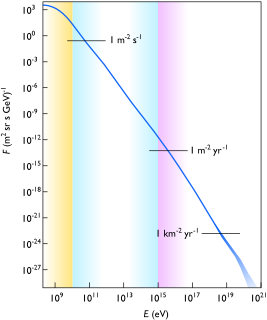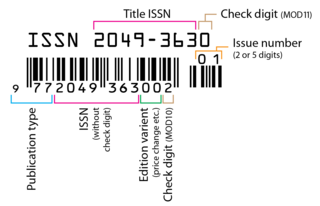
A Geiger counter is an instrument used for detecting and measuring ionizing radiation. Also known as a Geiger–Mueller counter, it is widely used in applications such as radiation dosimetry, radiological protection, experimental physics, and the nuclear industry.
A radiation dosimeter is a device that measures exposure to ionizing radiation. It is normally worn by the person being monitored as it is a personal dosimeter, and is a record of the radiation dose received. Older dosimeters, such as a film badge, require processing after use to reveal the cumulative dose received. Modern electronic personal dosimeters can give a continuous readout of cumulative dose and current dose rate, and can warn the person wearing it when a specified dose rate or a cumulative dose is exceeded.

The sievert is a derived unit of ionizing radiation dose in the International System of Units (SI) and is a measure of the health effect of low levels of ionizing radiation on the human body. The sievert is of importance in dosimetry and radiation protection, and is named after Rolf Maximilian Sievert, a Swedish medical physicist renowned for work on radiation dose measurement and research into the biological effects of radiation.
The gray is a derived unit of ionizing radiation dose in the International System of Units (SI). It is defined as the absorption of one joule of radiation energy per kilogram of matter.
Radiation protection, also known as radiological protection, is defined by the International Atomic Energy Agency (IAEA) as "The protection of people from harmful effects of exposure to ionizing radiation, and the means for achieving this". The IAEA also states "The accepted understanding of the term radiation protection is restricted to protection of people. Suggestions to extend the definition to include the protection of non-human species or the protection of the environment are controversial". Exposure can be from a radiation source external to the human body or due to the bodily intake of a radioactive material.
Equivalent dose is a dose quantity H representing the stochastic health effects of low levels of ionizing radiation on the human body which represents the probability of radiation-induced cancer and genetic damage. It is derived from the physical quantity absorbed dose, but also takes into account the biological effectiveness of the radiation, which is dependent on the radiation type and energy. In the SI system of units, the unit of measure is the sievert (Sv).

Health physics is the applied physics of radiation protection for health and health care purposes. It is the science concerned with the recognition, evaluation, and control of health hazards to permit the safe use and application of ionizing radiation. Health physics professionals promote excellence in the science and practice of radiation protection and safety. Health physicists principally work at facilities where radionuclides or other sources of ionizing radiation are used or produced; these include hospitals, government laboratories, academic and research institutions, nuclear power plants, regulatory agencies, and manufacturing plants.
The ionization chamber is the simplest of all gas-filled radiation detectors, and is widely used for the detection and measurement of certain types of ionizing radiation; X-rays, gamma rays, and beta particles. Conventionally, the term "ionization chamber" is used exclusively to describe those detectors which collect all the charges created by direct ionization within the gas through the application of an electric field. It only uses the discrete charges created by each interaction between the incident radiation and the gas, and does not involve the gas multiplication mechanisms used by other radiation instruments, such as the Geiger counter or the proportional counter.
A Bonner sphere is a device used to determine the energy spectrum of a neutron beam. The method was first described in 1960 by Rice University's Bramblett, Ewing and Tom W. Bonner and employs thermal neutron detectors embedded in moderating spheres of different sizes. Comparison of the neutrons detected by each sphere allows accurate determination of the neutron energy. This detector system utilizes a few channel unfolding techniques to determine the coarse, few group neutron spectrum. The original detector system was capable of measuring neutrons between thermal energies up to ~20 MeV. These detectors have been modified to provide additional resolution above 20 MeV to energies up to 1 GeV.
The Bulgarian cosmonaut program refers to human spaceflight efforts by the People's Republic of Bulgaria. The idea of a Bulgarian manned space mission predated the launch of Sputnik 1, the first artificial satellite. An informal proposal for the Soviet Union to send a Bulgarian cosmonaut in space was issued in 1964, but it was not seriously considered by the Soviets. Official space cooperation began in 1966 with the establishment of the Interkosmos programme which allowed Communist Bloc countries to access Soviet space technology and assets.

Radiation monitoring involves the measurement of radiation dose or radionuclide contamination for reasons related to the assessment or control of exposure to radiation or radioactive substances, and the interpretation of the results.

The roentgen or röntgen is a legacy unit of measurement for the exposure of X-rays and gamma rays. It is defined as the electric charge freed by such radiation in a specified volume of air divided by the mass of that air.
In 1928 it was the first international measurement quantity for ionising radiation to be defined for radiation protection, and was an easily replicated method of measuring air ionization directly by using an ion chamber. It is named after the German physicist Wilhelm Röntgen, who discovered X-rays.
Science and technology in Bulgaria is carried out in a variety of institutions, largely dominated by the Bulgarian Academy of Sciences (BAS) and several universities.
Institute for Nuclear Research and Nuclear Energy (INRNE) of the Bulgarian Academy of Sciences is
the leading center for research and application of the nuclear physics in Bulgaria.

A thermoluminescent dosimeter, or TLD, is a type of radiation dosimeter. A TLD measures ionizing radiation exposure by measuring the intensity of visible light emitted by a crystal inside the detector when the crystal is heated. The intensity of light emitted is dependent upon the radiation exposure. Materials exhibiting thermoluminescence in response to ionizing radiation include calcium fluoride, lithium fluoride, calcium sulfate, lithium borate, calcium borate, potassium bromide, and feldspar. It was invented in 1954 by Professor Farrington Daniels of the University of Wisconsin-Madison.
The Sarayköy Nuclear Research and Training Center, known as SANAEM, is a nuclear research and training center of Turkey. The organization was established on July 1, 2005 as a subunit of Turkish Atomic Energy Administration at Kazan district in northwest of Ankara on an area of 42.3 ha.

The nested neutron spectrometer (NNS) is a tool used for neutron spectroscopy. The NNS is used to measure the energy spectrum of neutrons in a neutron field. This type of detector is used in both research facilities and workplaces, where neutron radiation maybe encountered, for radiation protection purposes. Due to the difficulty associated with the detection of neutrons, the NNS is one of the few pieces of equipment capable of accurately determining the characteristics of a neutron field.
Epaminondas George Aristotle Alexander Stassinopoulos is the retired head of the Radiation Physics Office and current Emeritus Astrophysicist at the National Aeronautics and Space Administration (NASA)'s Goddard Space Flight Center in Greenbelt, Maryland. He is the author of numerous papers and articles in the field of space radiation.

Liulin-type is a class of spectrometry-dosimetry instruments.












